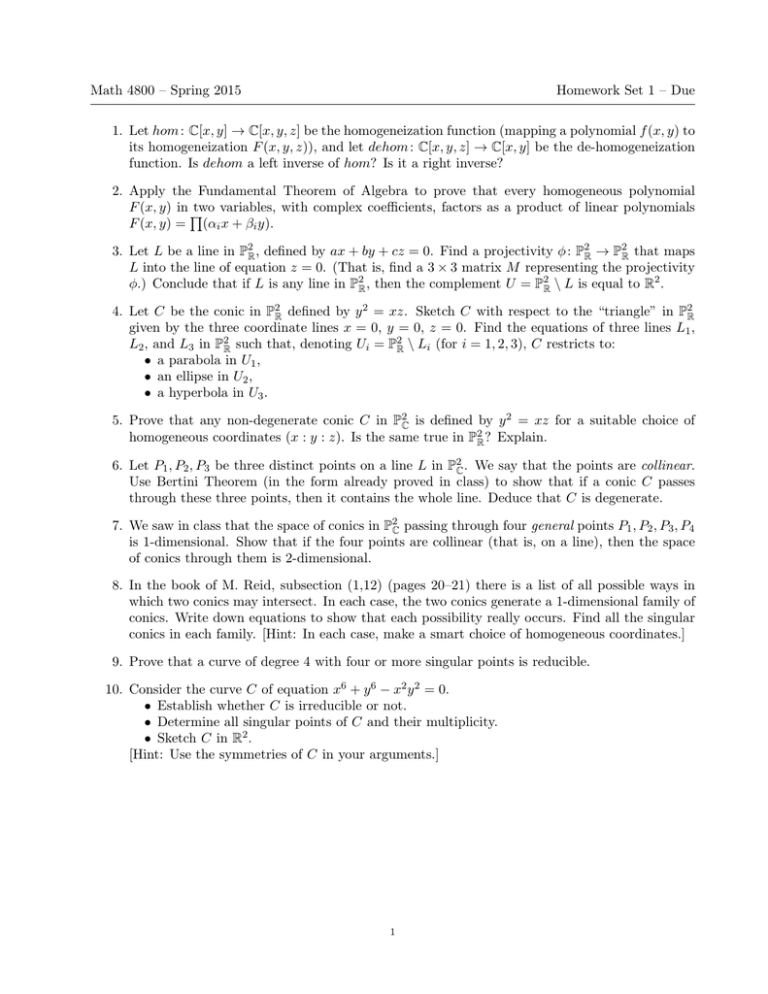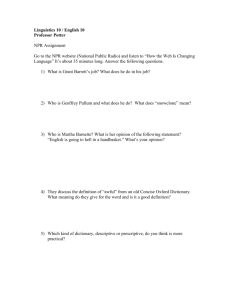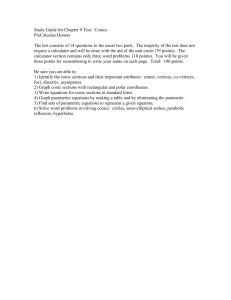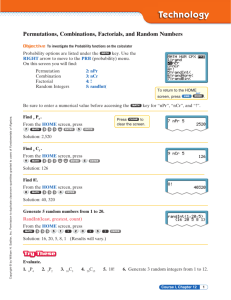Math 4800 – Spring 2015 Homework Set 1 – Due
advertisement

Math 4800 – Spring 2015 Homework Set 1 – Due 1. Let hom : C[x, y] → C[x, y, z] be the homogeneization function (mapping a polynomial f (x, y) to its homogeneization F (x, y, z)), and let dehom : C[x, y, z] → C[x, y] be the de-homogeneization function. Is dehom a left inverse of hom? Is it a right inverse? 2. Apply the Fundamental Theorem of Algebra to prove that every homogeneous polynomial F (x, y) in Q two variables, with complex coefficients, factors as a product of linear polynomials F (x, y) = (αi x + βi y). 3. Let L be a line in P2R , defined by ax + by + cz = 0. Find a projectivity φ : P2R → P2R that maps L into the line of equation z = 0. (That is, find a 3 × 3 matrix M representing the projectivity φ.) Conclude that if L is any line in P2R , then the complement U = P2R \ L is equal to R2 . 4. Let C be the conic in P2R defined by y 2 = xz. Sketch C with respect to the “triangle” in P2R given by the three coordinate lines x = 0, y = 0, z = 0. Find the equations of three lines L1 , L2 , and L3 in P2R such that, denoting Ui = P2R \ Li (for i = 1, 2, 3), C restricts to: • a parabola in U1 , • an ellipse in U2 , • a hyperbola in U3 . 5. Prove that any non-degenerate conic C in P2C is defined by y 2 = xz for a suitable choice of homogeneous coordinates (x : y : z). Is the same true in P2R ? Explain. 6. Let P1 , P2 , P3 be three distinct points on a line L in P2C . We say that the points are collinear. Use Bertini Theorem (in the form already proved in class) to show that if a conic C passes through these three points, then it contains the whole line. Deduce that C is degenerate. 7. We saw in class that the space of conics in P2C passing through four general points P1 , P2 , P3 , P4 is 1-dimensional. Show that if the four points are collinear (that is, on a line), then the space of conics through them is 2-dimensional. 8. In the book of M. Reid, subsection (1,12) (pages 20–21) there is a list of all possible ways in which two conics may intersect. In each case, the two conics generate a 1-dimensional family of conics. Write down equations to show that each possibility really occurs. Find all the singular conics in each family. [Hint: In each case, make a smart choice of homogeneous coordinates.] 9. Prove that a curve of degree 4 with four or more singular points is reducible. 10. Consider the curve C of equation x6 + y 6 − x2 y 2 = 0. • Establish whether C is irreducible or not. • Determine all singular points of C and their multiplicity. • Sketch C in R2 . [Hint: Use the symmetries of C in your arguments.] 1


